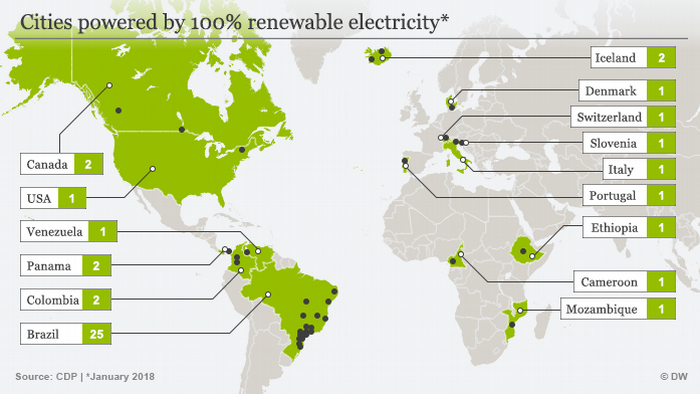Cities Leading the Transition to Renewables
More than 100 cities worldwide get at least 70 percent of their electricity from renewable sources. What can we learn from them?
Read the entire article at DW.
Cities are responsible for 70 percent of man made CO2 emissions, according to the International Renewable Energy Agency. Cars, heating, cooling and lighting systems work round the clock, consuming energy and pumping out emissions. But more and more cities are sourcing a growing share of that energy from renewables, to combat climate change.
Reykjavik already gets its electricity and heat from geothermal and hydropower. Basel, Switzerland, get’s all its electricity from a 100-renewable city-owned supplier. Many other European cities are moving towards renewables, not only for electricity, but also for heating and transport.
Falling green power prices are helping drive this transition. In 2017, unsubsidized renewables were the cheapest source of electricity in 30 countries, and renewable energy is predicted to become far cheaper than energy from fossil fuels by 2020.
Despite US President Donald Trump’s resistance to the energy transition (or because of it), US cities are redoubling their efforts, too. Across the country, 58 cities have committed to going 100-percent renewable. Of these, 46, including big cities like Atlanta and San Diego, only pledged after Trump’s election.
The Global Covenant of Mayors for Climate and Energy has also been a major push for local urban energy transitions, seeing more than 7,000 cities and local governments around the world agree to act on climate change. Cities are very much willing to learn from each other and replicate solutions or ways of overcoming risks.
It’s also important that the energy transition is an inclusive process, the Intergovernmental Panel on Climate Change recently stressed, bringing the public and local industry into decision-making to ensure everyone does their bit. Involving the local private sector means the energy transition can stimulate entrepreneurship and job creation. Vancouver, Canada, for example, included local businesses in a strategy that has seen the city achieve a 98-percent renewable electricity supply.


